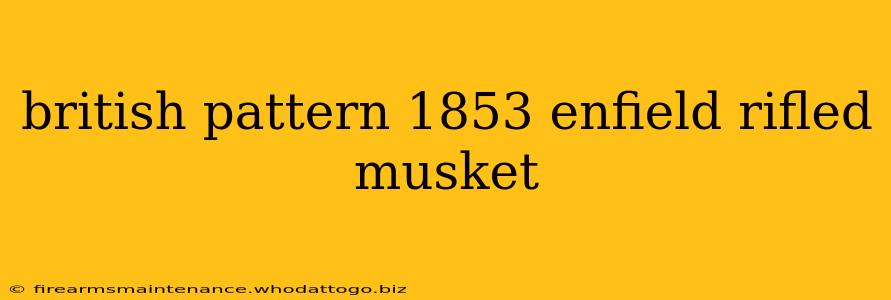The Pattern 1853 Enfield Rifled Musket stands as a pivotal weapon in military history, a testament to Victorian-era ingenuity and a significant step forward in firearm technology. This iconic rifle played a crucial role in conflicts across the globe, leaving an indelible mark on warfare and shaping the development of future firearms. This in-depth exploration delves into the design, production, use, and lasting legacy of this remarkable weapon.
Design and Innovation: A Technological Leap Forward
Before the 1853 Enfield, smoothbore muskets dominated battlefields. Their inaccuracy at longer ranges was a significant tactical disadvantage. The Pattern 1853 addressed this deficiency by incorporating a rifled barrel, imparting spin to the projectile for increased accuracy and range. This was a considerable technological advancement, allowing soldiers to effectively engage targets at distances previously unimaginable.
The rifle's design featured a distinctive three-groove rifling, a .577-inch caliber bore, and a distinctive percussion cap ignition system. The relatively simple design allowed for efficient mass production, crucial for equipping the vast British Army. The incorporation of a relatively powerful cartridge, featuring a paper-wrapped bullet and gunpowder charge, further enhanced its effectiveness. While not perfect—early versions suffered from inconsistent ammunition—the 1853 Enfield represented a substantial leap forward in small arms technology.
Key Design Features:
- Rifled Barrel: The defining feature, dramatically increasing accuracy and range.
- .577 Caliber: The large bore contributed to stopping power.
- Percussion Cap Ignition: A reliable ignition system for the time.
- Paper Cartridge: While problematic initially, it streamlined loading.
Production and Deployment: Arming the Empire
The British government recognized the importance of mass production to equip its vast forces. Several factories across Britain, including the Royal Small Arms Factory at Enfield Lock, were dedicated to manufacturing the 1853 Enfield in enormous quantities. Thousands upon thousands of these rifles were produced, arming British soldiers across the globe.
The Enfield's deployment spanned numerous conflicts, including:
- The Indian Mutiny (1857-1859): The Enfield played a crucial role in suppressing the rebellion.
- The Crimean War (1853-1856): Though initially limited in numbers, it saw use towards the end of the conflict.
- American Civil War (1861-1865): Both Union and Confederate forces used captured or imported Enfields.
Operational Use and Limitations: Battlefield Realities
Despite its advancements, the 1853 Enfield wasn't without its flaws. Early ammunition inconsistencies led to reliability issues, and the relatively complex loading process could slow down soldiers under fire. The paper cartridge, while convenient, proved problematic in damp conditions. The Enfield's length also made it less maneuverable in close-quarters combat. However, the advantages in accuracy and range significantly outweighed these drawbacks for many military strategists of the time.
Legacy and Lasting Impact: A Defining Weapon
The British Pattern 1853 Enfield Rifled Musket represents a significant turning point in military history. It heralded the shift from smoothbore muskets to rifled firearms, fundamentally changing infantry tactics and battlefield dynamics. Its widespread use and influence on subsequent rifle designs solidify its place as a pivotal weapon of the 19th century. The 1853 Enfield wasn't just a weapon; it was a symbol of technological progress and a key component of the British Empire's military power. Its legacy continues to inspire collectors and historians to this day, a testament to its historical significance.
(Note: This article is for informational purposes only and does not endorse any specific viewpoints or actions.)

